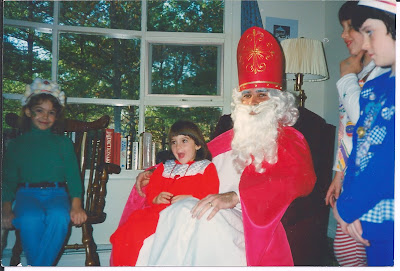
 This week and next many homes, parishes, and schools will have St. Nicholas parties and a visit from St. Nicholas to the children. Treats will be left secretly in empty shoes placed outside classrooms, on back decks, or in an out of the way hall.
This week and next many homes, parishes, and schools will have St. Nicholas parties and a visit from St. Nicholas to the children. Treats will be left secretly in empty shoes placed outside classrooms, on back decks, or in an out of the way hall.The children will pad around in stocking feet playing games, making homemade bishops' mitres, and decorating cookies. Collections will be taken for those less fortunate. At the end of the party, peals of delight will be heard when their shoes are discovered full of goodies and a holy card of St. Nicholas.
As you plan your party here are two more recipes, one very traditional and one contemporary to add to your collection. I have included a traditional prayer to St. Nicholas also at the end of this post.
PEPERNOTEN
(Spicy Cookie Balls)
Here is a tasty, traditional treat children in the Netherlands look for from St. Nicholas on his feast!
PREP: 20 minutes BAKE: 15 – 20 minutes
INGREDIENTS
2 cups flour
½ teaspoon baking powder
¼ teaspoon cinnamon
¼ teaspoon ground anise seed
¼ teaspoon ground cloves
¼ teaspoon nutmeg
2 large eggs
1 tablespoon diced candied orange rind
EQUIPMENT
medium-size mixing bowl
large spoon
measuring cups
measuring spoons
cookie sheets (2)
airtight container
DIRECTIONS: 350 degree oven YIELD: 60 small cookies
1 Sift flour with baking powder and spices. Add remaining ingredients and combine until mixture forms a dough.
2 With floured hands, form the dough into about 60 ½ inch balls and place on greased cookie sheets. Bake at 350 degrees for 15 – 20 minutes, until they are light brown. Cool. Enjoy.
3 Store in an airtight container.
This recipe can be prepared in the home or in a school or CCD class that has access to a kitchen. It can be baked in a few short minutes. Be creative and try different kinds of refrigerated cookie dough and candy bars. It is sure to be a great hit!
PREP: 5 – 10 minutes BAKE: 10 – 12 minutes
INGREDIENTS
1 roll of refrigerated cookie dough
Oatmeal slice and bake or other varieties
(May use dough in tubs also)
2 chocolate-covered caramel-nougat
candy bars
EQUIPMENT
2 cookie sheets
knife
fork or cookie edger
wire rack
DIRECTIONS: YIELD: 20 treats
1 Preheat oven to 350 degrees
2 Slice refrigerated cookie dough into ¼ -inch thick slices or use dough from tub and approximate the same size.
3 Cut each candy bar into 10 equal slices.
4 Place half the cookie slices 2 inches apart on 2 ungreased cookie sheets.
5Put a slice of candy on each. Top with remaining cookie slices.
6 Press edges together with tines of fork or cookie edger, carefully sealing all edges of the cookies.
7 Bake 10 – to 12 minutes or until lightly browned.
8 Cool slightly on cookie sheets until firm. Remove to wire rack to cool completely. Makes about 20 treats.
Prayer to St. Nicholas
and Saint, Nicholas. We love and honor his memory because of his tender concern for children and the
poor. We thank you for the merriment that his feast has brought down all the centuries. We ask you from
the bottom of our hearts to help us to remember, on this his feast day, that we should try to retain the
innocence of childhood and a sincere faith in you all our lives. Show us, too, how to share the good
things that we have with others, and to imitate St. Nicholas in generosity and goodwill. We ask him to
pray, for us from his place in Heaven.










